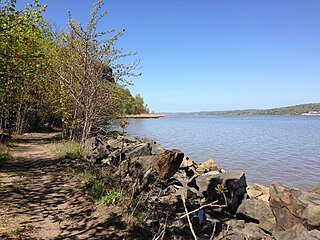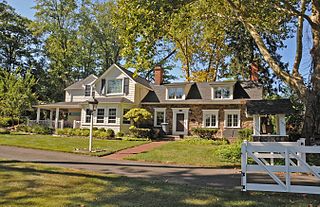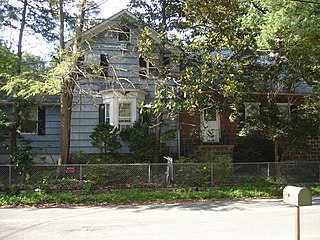
Bergen County is the most populous county in the U.S. state of New Jersey. As of the 2020 United States Census, the county's population was 955,732, an increase of 50,616 (5.6%) from the 905,116 residents enumerated in the 2010 census by the United States Census Bureau, which in turn represented an increase of 20,998 (2.4%) from the 884,118 counted in the 2000 Census. Located in the northeastern corner of New Jersey and its Gateway Region, Bergen County is part of the New York City metropolitan area and is directly across the Hudson River from Manhattan, to which it is connected by the George Washington Bridge.

Rochelle Park is a township in Bergen County, New Jersey, United States. As of the 2010 United States Census, the township's population was 5,530, reflecting an increase of 2 (+0.0%) from the 5,528 counted in the 2000 Census, which had in turn declined by 59 (-1.1%) from the 5,587 counted in the 1990 Census.

Teaneck is a township in Bergen County, New Jersey, United States, and a bedroom suburb in the New York metropolitan area. As of the 2010 United States Census, the township's population was 39,776, reflecting an increase of 516 (+1.3%) from the 39,260 counted in the 2000 Census, which had in turn increased by 1,435 (+3.8%) from the 37,825 counted in the 1990 Census. As of 2010, it was the second-most populous among the 70 municipalities in Bergen County, behind Hackensack, which had a population of 43,010.

Hackensack is a city in Bergen County in New Jersey, United States, and serves as its county seat. The area was officially named New Barbadoes Township until 1921, but has informally been known as Hackensack since at least the 18th century. As of the 2020 United States Census, the city's population was 46,030.

Rutherford is a borough in Bergen County, New Jersey, United States. As of the 2020 United States Census, the borough's population was 18,834.

Fairleigh Dickinson University is a private university with its main campuses in the U.S. state of New Jersey. Founded in 1942, Fairleigh Dickinson University currently offers more than 100 degree programs to its students. In addition to its two campuses in New Jersey, the university also has a campus in Canada, a campus in the United Kingdom, and an online platform. Fairleigh Dickinson University is New Jersey's largest private institution of higher education, with over 12,000 students.

The Hackensack River is a river, approximately 45 miles (72 km) long, in the U.S. states of New York and New Jersey, emptying into Newark Bay, a back chamber of New York Harbor. The watershed of the river includes part of the suburban area outside New York City just west of the lower Hudson River, which it roughly parallels, separated from it by the New Jersey Palisades. It also flows through and drains the New Jersey Meadowlands. The lower river, which is navigable as far as the city of Hackensack, is heavily industrialized and forms a commercial extension of Newark Bay. Once believed to be among the most polluted watercourses in the United States, it staged a modest revival by the late 2000s.

Overpeck Creek is a tributary of the Hackensack River, approximately 8 miles (13 km) long, in Bergen County in northeastern New Jersey in the United States. The lower broad mouth of the creek is part of the extended tidal estuary of the lower Hackensack and of the adjacent wetland region known as the New Jersey Meadowlands.
New Bridge was a prosperous mill hamlet, centered upon a bridge strategically placed at the narrows of the Hackensack River. In the American Revolution, New Bridge Landing was the site of a strategic bridge crossing the Hackensack River, where General George Washington led his troops in retreat from British forces November 20, 1776. Eleven engagements took place here throughout the war. The current Draw Bridge at New Bridge was installed in 1889 and added to the National Register of Historic Places on July 5, 1989. The area is now a New Jersey historic site in portions of New Milford, River Edge, Hackensack and Teaneck in Bergen County, New Jersey, United States.
Ridgefield Township was a township that existed in Bergen County, New Jersey. The township was created in 1871, when Hackensack Township was trisected to form Palisades Township in the northernmost third, Englewood Township in the central strip and Ridgefield Township encompassing the southernmost portion, stretching from the Hudson River on the east to the Hackensack River, with Hudson County to the south. Much of the area had been during the colonial area known as the English Neighborhood. As described in the 1882 book, History of Bergen and Passaic counties, New Jersey,
Ridgefield is the first township in Bergen County which the traveler enters in passing up the Palisades. His first impressions are much like those of old Hendrick Hudson in speaking of a wider extent of country: "A very good land to fall in with, and a pleasant land to see." The valley of the Hackensack invited early settlers in the seventeenth century, and the valley of the Overpeck Creek, a navigable arm of the Hackensack, also attracted settlers quite as early in this direction. Sloops and schooners can pass up this creek nearly to the northern boundary of the township. Ridgefield is bounded on the north by Englewood, on the east by the Hudson, on the south by Hudson County, and on the west by the Hackensack River. The southern boundary is less than two miles in extent, and the northern less than four, and the length of the township from north to south does not exceed four miles. Bellman's Creek, forming part of the southern boundary, the Hackensack, the Overpeck, the Hudson, with more than a dozen other smaller streams and rivulets, bountifully supply the whole township with water. From the western border of the Palisades the land descends to the Overpeck, forming a most beautiful valley, with the land again rising to a high ridge midway between the Overpeck and the Hackensack. From this long ridge, extending far to the north beyond this township, it took its name of Ridgefield.
The New York, Susquehanna and Western, formerly the Midland Railroad, the Jersey City and Albany Railroad, and the Northern Railway of New Jersey—all running northward through the township— afford ample railroad accommodations. The Susquehanna enters the township at Bellman's Creek, and the Northern at about one hundred feet south of the creek, and at a point north and east of the Susquehanna. The Albany road in this locality is not yet constructed, diverging at present from the track of the Susquehanna between Little Ferry and Bogota stations. It has, however, an independent line projected and now under construction to New York City.
Early Settlements. Ridgefield embraces the earliest settlements in the ancient township of Hackensack, antedating even the organization of that township in 1693, and of the county of Bergen in 1675. There seems to have been no town or village compactly built, like the village of Bergen, but there were settlements both of Dutch and English in and about what was subsequently known as English Neighborhood prior to 1675. The Westervelts, the Zimcrmans, the Bantas, and the Blauvelts, all coming from Holland, settled in the middle of the seventeenth century in that locality. The ancestors of Jacob P. Westervelt, now of Hackensack Village, with himself, were born in English Neighborhood. His father was born there in 1776, and was the son of Christopher Westervelt, who was born there certainly as early as 1690, and he was the son of the original ancestor of this family, who came from Holland and settled on Overpeck Creek, within the present limits of Ridgefield township, probably about 1670.

The Steuben House is a noted example of Bergen Dutch sandstone architecture, located at New Bridge Landing on the Hackensack River in River Edge, in Bergen County, New Jersey, United States.

The Terhune House is located at 161 Godwin Avenue in Wyckoff, Bergen County, New Jersey, United States. The house was initially constructed in 1737, with the second major renovation occurring in 1776. Terhune family lore suggests that the family were French Huguenots who fled France in the 16th century to pursue their religious beliefs. The family settled in Holland and after two or three generations of intermarrying within the Dutch community they set their sights on Pre-Colonial America. Albert Albertse ter Hune arrived on the shores of New Netherland from Holland in December 1637. Arriving on the ship “Calmar Sleutel” he settled, for what would become the 1st of 15 generations of Terhunes in North America.

Bergen County, New Jersey had a series of court houses. The current one stands in Hackensack, New Jersey.

The Van Wagenen House, also known as Apple Tree House, is located near Bergen Square in Jersey City, Hudson County, New Jersey, United States. The house was added to the National Register of Historic Places on August 16, 2006.

Demarest station is located in Demarest, Bergen County, New Jersey, United States. The station's depot was added to the National Register of Historic Places on July 7, 2004.

The bridge at New Bridge Landing, New Jersey was built in 1888 to replace an earlier wooden one, and was added to the National Register of Historic Places on July 5, 1989.

The Albert J. Zabriskie Farmhouse is located at the current address of 7 East Ridgewood Avenue in Paramus, Bergen County, New Jersey, United States, just east of New Jersey Route 17. This is one of several Zabriskie historic sites associated with the descendants of prominent settler Albrycht Zaborowski (1638–1711). This stone house was built in 1805 by Albert Jacob Zabriskie (1760–1835) in the New Jersey Dutch style, owned by four generations of the family until 1924, and added to the National Register of Historic Places on November 7, 1977. Due to confusion from the street name and handwritten notes on one page of the NRHP nomination, the building is sometimes mistakenly listed as being in Ridgewood, New Jersey.

The Zabriskie Tenant House was a historic house of the American colonial architecture style called Dutch Colonial on Dunkerhook Road in Paramus, in Bergen County, New Jersey, United States, adjacent to the Saddle River County Park. The Zabriskie family, who farmed much of the area to the east of the Saddle River, built the home to house their domestic workers. It was one of the few structures left in New Jersey directly related to free African American communities in the state, and was a remnant of an African American Dunkerhook community that included several homes and an A.M.E. Church. The house was added to the National Register of Historic Places on July 24, 1984.

Garretson Forge and Farm is a farm owned by the Garretson Family since 1719. Located in Fair Lawn, Bergen County, New Jersey, United States, it is one of the oldest historic sites in the county. The Peter Garretson House was built in 1720 and was added to the National Register of Historic Places on November 19, 1974.

The Court Street Bridge, also known as the Harold J. Dillard Memorial Bridge, is a vehicular movable bridge crossing the Hackensack River between Hackensack and Bogota in Bergen County, New Jersey, which owns it. Located 16.2 miles (26.1 km) from the river mouth at Newark Bay, the swing bridge, which opened in 1908 and underwent major rehabilitation in 2010–2012, is the most-upstream bridge on the river required by federal regulations to open on request.


















